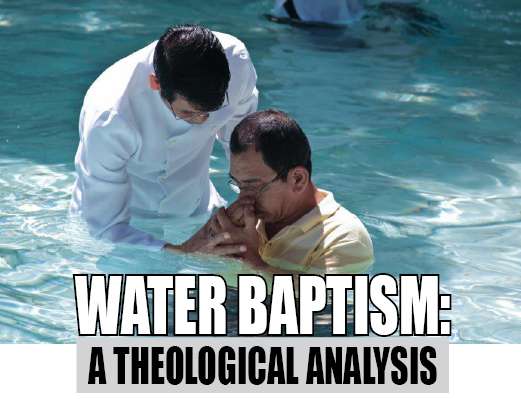
Water Baptism: A Theological Analysis
Pr. Mathew V. S.
Baptism is one of the ordinances instituted by Christ. The word 'baptism' is derived from the Greek term means to plunge, dip, immerse something in water. In the N.T, the term baptism is used differently, e.g baptism of John the Baptist, Christian water baptism, baptism of suffering (Lk 12::49-50, Mk 10:38-40), baptism with the Holy Spirit (Acts 1:5,8, 2:1-4), Baptism unto Moses (I Cor.10:1-4), baptized for the dead (I Cor 15:29). This article mainly focusses on the theological aspects of the water baptism as well as its mode etc.
The Institution of Water baptism
It was instituted with divine authority. It was instituted by Christ after he had finished the work of reconciliation. It is worthy of notice that he prefaced the great commission with the words, All authority had been given unto Me in heaven and on earth. The great commission is as follows, "Go you therefore …to the end of the age (Mt 28:19-20). The following elements are clearly indicated in this authoritative command.
(a) The disciples were to go out into the whole world and to preach the gospel to all nations in order to bring people to repentance
(b) Those who accepted Christ by faith were to be baptized in the name of the Triune God
(c) They were to be brought under the ministry of the Word, not merely as a proclamation of the good news, but as an exposition of mystery, the privileges and the duties of the new covenant.
The mode of baptism
Churches are divided over this issue. Some follow immersion where as others sprinkling. The practise of baptism in the New Testament was carried out in one way. The person being baptized was immersed or put completely under water and then brought back up again. Baptism by immersion is the mode of baptism or the way in which baptism was carried out in the New Testament. This is evident for the following reasons.
(1) In Mark1:5, people were baptized by John in the river Jordan. Mark also tells that when Jesus had been baptized he came up out of the water (Mk 1:10). The fact that John and Jesus went into the water and came up out of it strongly suggests immersion. In the case of baptism of the Ethiopian eunuch went down into the water and came up out of the water suggest immersion baptism (Acts 8:38-39)
(2) The symbolism of union with Christ in His death, burial and resurrection seems to require baptism by immersion (Rom. 6:3-4). Paul tells the Colossians “You were buried with him in baptism in which you were also raised with Him through faith in the working of God, who raised him from the dead." (Col 2:12)
(3) When the candidate for baptism goes down into the water it is a picture of going down into the grave and being buried. Coming up out of the water is then a picture of being raised with Christ to walk in newness of life. Baptism thus very clearly pictures death to one’s old way of life and rising to a new kind of life in Christ. Wayne Grudem says: "the waters of baptism have an even richer symbolism than simply the symbolism of the grave. The waters also remind us of the waters of God’s judgement that came upon unbelievers at the time of the flood (Gen. 7:6-24), or the drowning of the Egyptians in the exodus (Ex.14:26-29). Therefore, those who go down into the waters of judgement and death, when they come back out of the water, it shows that they have come safely through God’s judgement only because of the merits of Jesus Christ, with who they are united in his death and resurrection. (Wayne Grudem, Systematic Thelology (Grand Rapids, Michigan: Zondervan,1994)P.850).
The Subjects of the baptism
Baptism should only be given to those who give a believable profession of faith. There are several N.T passages which support the view. Some of them are given below. After Peter’s sermon at Pentecost we read “those who received his word were baptized (Acts 2:41) when Philip preached the gospel in Samaria, we read when they believed Philip as he preached good news about the kingdom of God they were baptized, both men and women (Acts 8:12, 10:44-46, 16:14-15).
Theology of water baptism.
There are various passages related to the theology of the baptism. Few of them will be exposed. Paul used different imageries for the water baptism to describe its meaning. Let us discuss a some of them.
Putting on Christ
Gal. 3:27 says for all of you were baptized into Christ have clothed yourselves with Christ. The members of the Galatians churches had undergone baptism as adult believers, Paul now reminds them of the experience of initiation., a marker of their passage into new life. This imagery is used in Gal.3:27 and Col 3:9-14. The imagery of stripping of clothes and putting on fresh ones to indicate a transformation of character in the Old Testament (Is. 52:1, 61:19, Zech 1;15). This symbolism was particularly apt for apostolic times. Some scholars say that this is a baptismal formula existed in the early church. In structure it resembles the five trustworthy sayings recorded in the pastoral epistles (I Tim.1:15; 3:1; 4:9; II Tim 2:11, Tit 3;8)
Putting off and putting on is frequently found in Paul's writings where it often connotes the ethical transformation expected of a true believer, i.e putting off the deeds of darkness and putting on the armour of light (Rom. 13:11-14). What do we mean by the phrase, 'clothed in' a person? It is another figurative way of describing our close union with Christ to which Paul referred in Gal. 2;20. In such a union those who are in Christ share in His divine sonship and take on His character. V:28 mentions the implication of the transformation with reference to the abolition of three categories. It says, There is no longer Jew or Greek, there is no longer slave or free, there is no longer male and female; for all of you are one in Christ (NRSV).
There is no longer Jew or Greek: This is a reference to the fact that racial barrier is broken down in Christ. Jews always take pride in their racial purity and undermine Gentiles. Eph 2:15 says, He has created a new humanity in Himself by abolishing dividing wall of hostility.
There is no longer slave or free: In the New Testament era slaves were not given same rights as those free. They were different categories of humanity, but in Christ that changes. Slaves and free are equal heirs and beneficiaries of Abrahamic covenants of blessing. Therefore, social barrier is broken in Christ. Now a new identity is given to all that are children of God. Now they are related to one another, as brothers and sisters.
There is no longer male and female: In the previous two categories the pattern is there is no longer a or b, c or d. But in the third category the pattern is there is no longer male and female. What is the reason? Paul echoes the language of Gen. 1:27 the male and female he created them. It means that these distinctions are no longer the determinative identity marker, no longer a ground for status or exclusion. Church as a transformed community of men and women have equal status. This does not ignore the fact that men and women have different roles to play in the created order.
Union with Christ
Since we already discussed this aspect under the heading mode of baptism, we need not explain it again. All of us who have been baptized into Christ Jesus were baptized into his death? Therefore we have been buried with him by baptism into death … so we too might walk in newness of life (Rom 6:3-4; cf Col 2:11-12; Gal 3:27). Paul incorporated the theology of baptism in Roman 6 to give ethical admonition to the readers. This passage comprises many imperatives, i.e you must consider yourselves dead to sin and alive to God (v:11). V:5 says For if we have been united with Him in a death like His, we will certainly be united with him in a resurrection like His. The Greek term used here for union is sumphuo meaning growing together. In baptism, the existence of the Christian is intertwined with that of the Christ, like two young trees whose trunks grow around one another.
To appeal for a good conscience
Peter says baptism now saves you not as a removal of dirt from the body, but as an appeal to God for a good conscience, through the resurrection of Jesus Christ (I Pet. 3:21). NIV translates the phrase as a pledge of a good conscience to God. The Greek term used for appeal is eperotema. Baptism is an inward, spiritual transaction between God and the individual. This phrase is another way of saying a request for forgiveness of sins and a new heart. The Lord gives a clear conscience so that person stands in a right relationship with God.
To fulfil the Righteousness
Jesus began his ministry by being baptized by John (Mt. 3:13-15). Jesus speaks for the first time in the gospel. Both righteousness and fulfilment are key Mathean themes. Righteousness here means the revealed will of God, Fulfil simply means 'do or perform'. Here, baptism is the will of God. By being baptized Jesus identified Himself with humanity.
To conclude we can say that water baptism is instituted by Christ. Churches are divided over the issue of mode of baptism. N.T advocates the baptism by immersion. Water baptism should only be given to those who accept Jesus Christ as their personal saviour. All those who were baptized into Christ have clothed with Christ. Putting on Christ is a figurative way of describing our mystical union with Christ. Social, racial and gender discrimination are broken in Christ. Church is a transformed community in which a new identity is given to its members irrespective of class, colour and gender. This declaration gives a radical vision to the society. Theological, social and gender significance of the water baptism should not be ignored.





